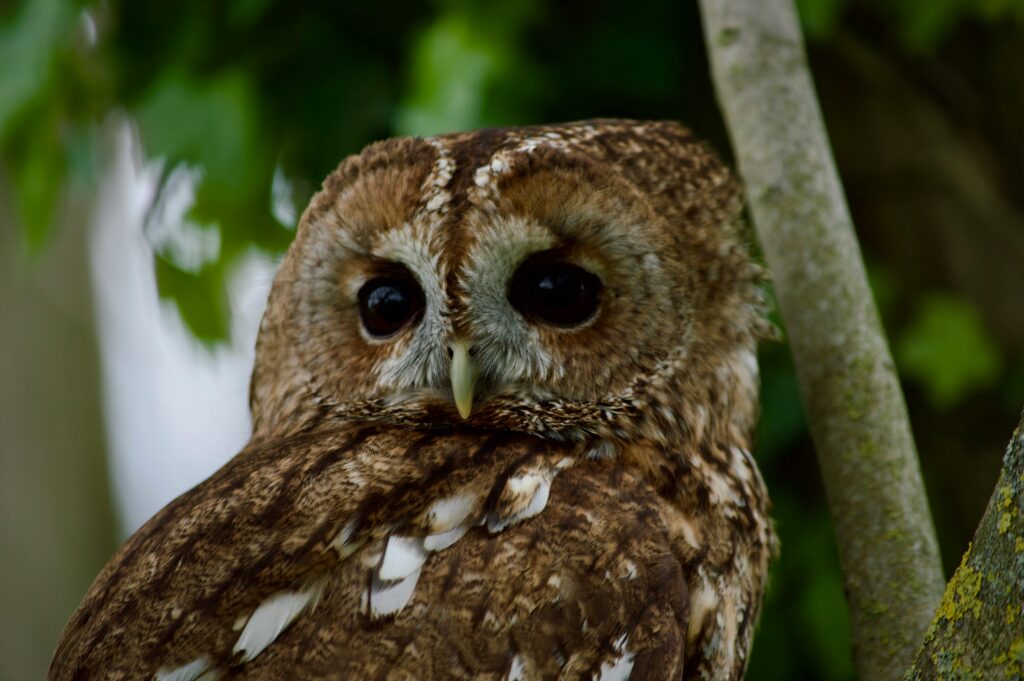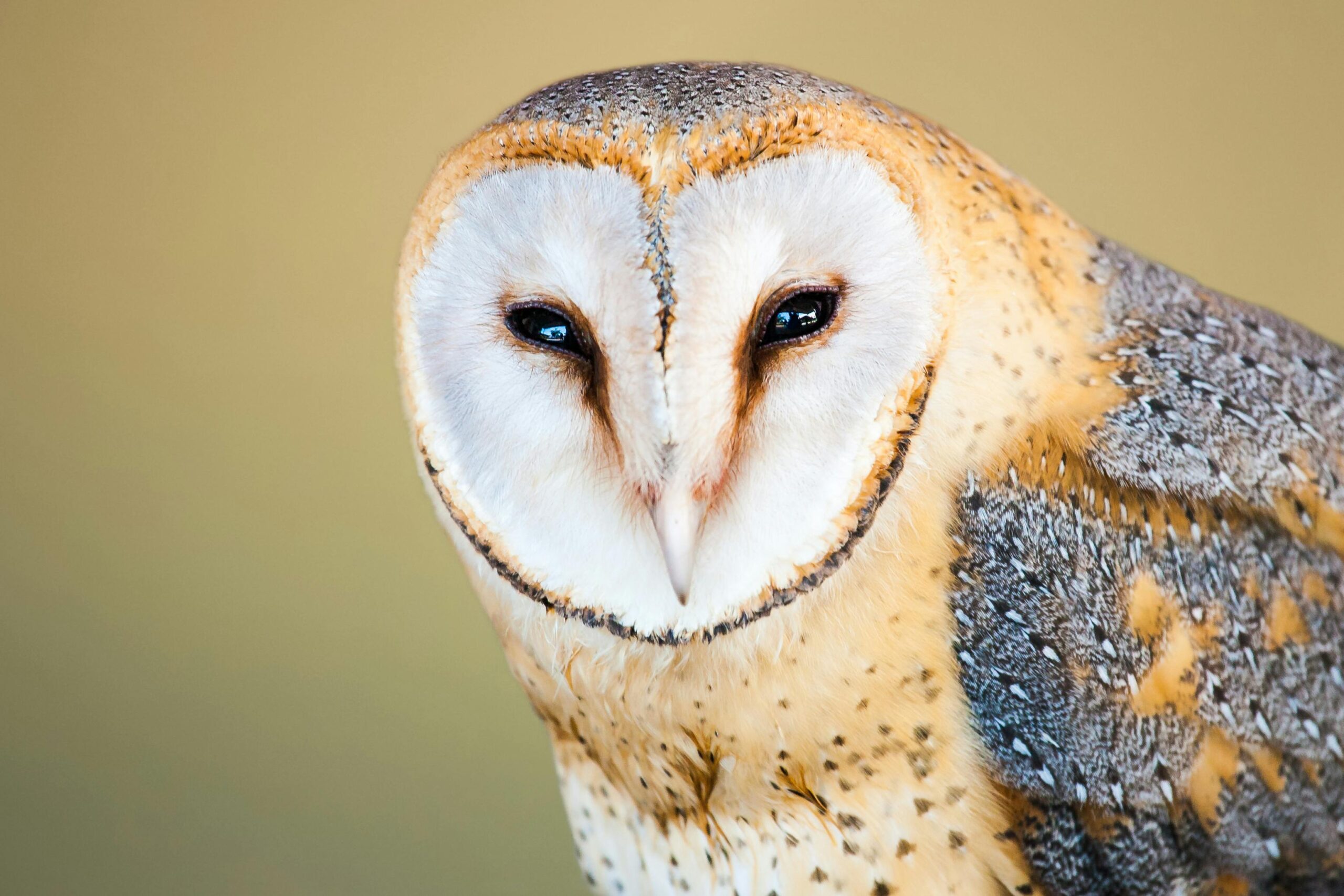Owls are among the most mysterious and captivating birds found in the UK. Known for their nocturnal habits, silent flight, and haunting calls, they play a crucial role in ecosystems as skilled predators of rodents and other small creatures.
The UK is home to five resident owl species, each with its own unique traits and habitat preferences. Additionally, there are occasional sightings of rare migratory or vagrant owls, adding to their mystique. This guide explores the different types of owls in the UK, their behaviours, habitats, and the ongoing efforts to protect them in an ever-changing environment.

Overview of Owl Species in the UK1
The UK is home to five resident species of owls, each uniquely adapted to their environment. From the ethereal barn owl to the diminutive little owl, these birds can be found across a range of habitats, from woodlands and grasslands to coastal areas and moorlands.
Owls are largely nocturnal or crepuscular (active during twilight), relying on their exceptional hearing and keen vision to hunt in low-light conditions. Their ability to fly silently makes them highly effective predators, ensuring their place at the top of the food chain in many ecosystems.
How Many Types of Owls Are Found in the UK?
The five resident species of owls in the UK are:
- Barn Owl (Tyto alba): Known for its ghostly appearance and silent flight, this species is a common sight in rural areas.
- Tawny Owl (Strix aluco): The UK’s most widespread owl, often heard hooting in woodlands and gardens.
- Little Owl (Athene noctua): A small, stocky owl introduced to the UK in the 19th century, often seen during daylight hours.
- Long-Eared Owl (Asio otus): A secretive owl with distinctive ear tufts, usually found in wooded areas.
- Short-Eared Owl (Asio flammeus): A diurnal owl frequently spotted hunting over open grasslands and moorlands.
In addition to these resident species, the UK occasionally hosts migratory or vagrant owls, such as the Eagle Owl and the Snowy Owl, which are rare but exciting sightings for birdwatchers.

The Mesmerizing Eyes of an Owl
One of the most captivating features of an owl is its eyes. Unlike most birds, owl eyes face forward, giving them a striking, human-like gaze and incredible binocular vision. This adaptation makes them extraordinary hunters, particularly in low-light conditions.
What Makes Owl Eyes Special?
- Adaptation for Night Vision:
Owls have large eyes that gather more light, allowing them to see in near-total darkness. Their retinas are packed with rod cells, which are highly sensitive to dim light. - Fixed Eye Position:
Unlike human eyes, owl eyes are fixed in their sockets, meaning they cannot move side-to-side. To compensate, owls have an extraordinary ability to rotate their heads up to 270 degrees, giving them a wide field of view. - Colour and Shape:
- Eye Colour as a Clue: The colour of an owl’s eyes often reflects its activity pattern. For example:
- Dark brown/black eyes (e.g., tawny owl): Nocturnal hunters.
- Bright yellow eyes (e.g., short-eared owl): Diurnal or crepuscular species.
- Orange eyes (e.g., long-eared owl): Active primarily at dusk and dawn.
- Tubular Shape: Owl eyes are more tube-shaped than spherical, further enhancing their ability to focus on distant objects.
- Eye Colour as a Clue: The colour of an owl’s eyes often reflects its activity pattern. For example:
- Exceptional Depth Perception:
Their forward-facing eyes allow for precise depth perception, crucial for accurately judging distances when swooping down on prey.
How Do Owl Eyes Compare to Other Birds?
While most birds rely heavily on their sharp colour vision during the day, owls have sacrificed colour perception for unparalleled night vision. Their eyes are designed to detect the slightest movements in near darkness, making them masters of nocturnal hunting.
Fun Fact About Owl Eyes
An owl’s eyes are so large relative to its body that they can weigh as much as its brain!
Barn Owl: The Ghostly Hunter
The barn owl is one of the UK’s most iconic birds, instantly recognisable by its heart-shaped face, pale plumage, and silent flight. Often referred to as the “ghost owl,” it is most active at dusk and dawn, gliding effortlessly over fields and meadows in search of prey. Barn owls are a symbol of rural Britain, typically associated with old barns, hedgerows, and grasslands.
Their ability to hunt in almost complete darkness is due to their exceptional hearing, which allows them to pinpoint the slightest rustle of movement from small mammals, even under thick vegetation.
What Makes the Barn Owl Unique?
Several factors make the barn owl a remarkable bird:
- Distinctive appearance:
- Snowy white underparts and golden upper plumage with grey markings.
- A heart-shaped facial disc that helps funnel sound to their ears.
- Diet and hunting style:
- Their diet consists mostly of small mammals, such as field voles, shrews, and mice.
- They use their keen hearing to detect prey and strike silently with their sharp talons.
- Nesting habits:
- Barn owls often nest in cavities within trees, barns, and abandoned buildings.
- They rely on undisturbed spaces to successfully raise their young.
- Conservation status:
- Once in decline due to habitat loss and pesticide use, barn owl populations have rebounded in recent years thanks to conservation efforts, including the installation of nest boxes.
With their ethereal beauty and vital role in controlling rodent populations, barn owls remain one of the UK’s most beloved bird species.
Tawny Owl: The Classic Woodland Owl
The tawny owl is the most common and widespread owl species in the UK, known for its classic “twit-twoo” call that echoes through woodlands and gardens at night. A true nocturnal bird, it is rarely seen during the day as it roosts in tree cavities or dense foliage. Tawny owls thrive in deciduous and mixed woodlands but can also adapt to urban parks and gardens with mature trees.
This species is highly territorial and often stays within the same territory throughout its life, defending it fiercely against other tawny owls.
Where Can You Find Tawny Owls?
Tawny owls are widely distributed across the UK, except for parts of Ireland, where they are not native. Here’s where and how you can find them:
- Preferred habitats:
- Deciduous woodlands with plenty of mature trees for roosting and nesting.
- Urban parks and gardens, particularly those near wooded areas.
- They avoid open landscapes like grasslands and moorlands, which lack suitable cover.
- Identifying features:
- Rounded body and head with brown, mottled plumage for excellent camouflage.
- Dark, soulful eyes set within a facial disc, giving them their iconic appearance.
- Calls and behaviour:
- The male’s distinctive “twoo” call and the female’s “kee-wick” combine to create the famous “twit-twoo.”
- Tawny owls are silent in flight, making them skilled ambush hunters of small mammals, birds, and insects.
Although they are a familiar sound of the British night, tawny owls can be elusive to spot. The best time to observe them is at dusk when they leave their roosts to begin hunting.
Little Owl: The Smallest UK Owl
The little owl is the UK’s smallest owl species, but it is no less fascinating than its larger relatives. Introduced to Britain in the 19th century from Europe, this charming bird has adapted well to farmland, orchards, and parklands. Its compact size, bold personality, and tendency to be active during the day make it one of the more visible owl species.
Unlike many other owls, little owls are often spotted perched on fence posts, branches, or stone walls, scanning the ground for prey. Their stocky build and bright yellow eyes give them an endearing yet fierce appearance.
What Do Little Owls Eat?
The diet of little owls is diverse, reflecting their opportunistic feeding behaviour. Here’s a closer look:
- Primary food sources:
- Insects, such as beetles, grasshoppers, and worms, make up a significant part of their diet during the warmer months.
- Small mammals, such as voles and mice, are consumed more frequently in winter.
- Other prey:
- Small birds, amphibians, and even reptiles may also be caught, particularly during breeding season when food demand increases.
- They are known to scavenge occasionally, feeding on carrion if available.
- Hunting behaviour:
- Little owls typically hunt from a perch, swooping down to grab prey with their sharp talons.
- Their small size and agility allow them to navigate low vegetation and narrow spaces effectively.
Little owls are most active during dawn and dusk, but their daytime activity and preference for open areas make them easier to spot than most other owl species. Their adaptability has made them a favourite among birdwatchers and photographers alike.
Long-Eared Owl: The Silent Night Hunter
The long-eared owl is a secretive and elusive species, often going unnoticed due to its excellent camouflage and nocturnal habits. Named for its distinctive “ear tufts” (which are actually feathers), this medium-sized owl is usually found in dense woodlands and forests but hunts over nearby open fields.
Long-eared owls are highly specialised hunters, relying on their sharp hearing and silent flight to locate and capture prey in the dark. Their haunting calls are rarely heard, making sightings even more challenging.
How Can You Spot a Long-Eared Owl?
Spotting a long-eared owl in the wild can be tricky, but understanding their habits and habitats can increase your chances:
- Preferred habitats:
- Dense coniferous or mixed woodlands, where they roost during the day.
- Nearby open grasslands or agricultural fields, where they hunt at night.
- They are more commonly seen in winter when they form communal roosts.
- Identifying features:
- Long, prominent ear tufts that are raised when the owl is alert.
- Mottled brown plumage for excellent camouflage against tree bark.
- Bright orange eyes that are striking in close encounters.
- Diet and hunting behaviour:
- Long-eared owls feed primarily on small mammals, especially voles, mice, and shrews.
- They use a combination of exceptional hearing and silent flight to ambush prey in open areas.
To find long-eared owls, look for communal roosts in winter, where multiple owls may gather in dense trees. If disturbed, they may fly out and reveal themselves briefly before retreating to another secluded spot.
Short-Eared Owl: The Daytime Owl
The short-eared owl is unique among UK owls for its diurnal behaviour, meaning it is frequently active during the day. This species is often spotted flying low over open landscapes such as grasslands, moorlands, and coastal marshes, hunting for prey in broad daylight. Its graceful, buoyant flight and piercing yellow eyes make it a favourite for birdwatchers.
Short-eared owls are migratory in the UK, with populations swelling during the winter as birds arrive from Scandinavia and other parts of Europe. Their distinctive appearance and daytime activity make them one of the easiest owl species to observe.
Why Are Short-Eared Owls Active During the Day?
Unlike most other owls, short-eared owls are well-adapted to hunting during daylight hours. Here’s why:
- Open habitats:
- Their preferred environments, such as moorlands and grasslands, are open and exposed, making hunting during the day more effective.
- The abundance of prey, such as voles, during the day allows them to conserve energy by avoiding competition with nocturnal predators.
- Hunting behaviour:
- They fly low over the ground with a slow, deliberate flight, scanning for movement before pouncing on their prey.
- Their excellent vision and hearing allow them to detect rodents even under thick vegetation.
- Seasonal activity:
- During winter, short-eared owls can often be seen hunting during the late afternoon, taking advantage of the limited daylight hours.
- In summer, their activity is more crepuscular (dawn and dusk) in northern breeding grounds.
Short-eared owls are highly mobile and can cover vast distances while foraging, making them a symbol of wilderness in the UK’s open landscapes. They are particularly common in coastal areas and uplands during winter, where their striking flight and daytime activity make them a highlight for birdwatchers.
Rare Visitors: Migratory and Uncommon Owls
While the UK is home to five resident owl species, there are occasional sightings of rare and migratory owls that add excitement for bird enthusiasts. These species are not native to the UK but may arrive as vagrants, blown off course during migration, or as seasonal visitors from colder regions. Their presence, though fleeting, highlights the diversity and adaptability of owls around the world.
What Other Owls Are Occasionally Seen in the UK?
Here are some of the rare and migratory owl species that are occasionally spotted in the UK:
- Snowy Owl (Bubo scandiacus):
- A striking white owl, famous from Arctic regions, occasionally visits the UK’s northern and coastal areas.
- Sightings are extremely rare, often occurring during winter when prey is scarce in their native tundra habitats.
- Eagle Owl (Bubo bubo):
- One of the largest owls in the world, with piercing orange eyes and immense wingspans.
- Rare sightings in the UK are believed to result from escaped captive birds or occasional vagrants from Europe.
- Scops Owl (Otus scops):
- A tiny owl with a high-pitched call, native to southern Europe and Africa.
- Sightings in the UK are rare, usually during migration.
- Tengmalm’s Owl (Aegolius funereus):
- A small, nocturnal owl native to boreal forests of Europe and Scandinavia.
- Rarely recorded in the UK, it is more likely to appear in northern Scotland during irruptive years (when populations expand due to food abundance).
These rare visitors often generate significant excitement among birdwatchers, who travel great distances to catch a glimpse. The presence of these owls underscores the importance of preserving habitats that can accommodate such occasional but fascinating species.
Conservation of Owls in the UK
Owls are integral to the ecosystems they inhabit, serving as predators that help control rodent populations. However, like many wildlife species, UK owls face a variety of threats, including habitat loss, pesticide use, and climate change. Conservation efforts play a crucial role in ensuring these majestic birds continue to thrive in Britain’s landscapes.
Public awareness and habitat restoration projects have led to positive outcomes for certain owl species, particularly barn owls, whose populations have rebounded thanks to targeted conservation efforts. Despite these successes, continued action is needed to protect the delicate balance of the ecosystems that owls depend on.
How Are Owl Populations Being Protected?
Several conservation initiatives and practices are helping safeguard the future of owls in the UK:
- Habitat restoration:
- Planting hedgerows, preserving grasslands, and maintaining woodlands provide critical nesting and hunting grounds for owls.
- Reducing agricultural intensification ensures habitats remain suitable for prey species like voles and mice.
- Nest boxes:
- Installing owl nest boxes has been highly effective, particularly for barn owls, in areas where natural nesting sites (such as hollow trees or old barns) are scarce.
- Reducing pesticide use:
- Limiting the use of rodenticides helps protect owls from secondary poisoning when they consume prey that has ingested these chemicals.
- Monitoring populations:
- Organisations like the Barn Owl Trust and British Trust for Ornithology (BTO) track owl populations to identify trends and respond to emerging threats.
- Citizen science efforts, such as bird surveys, help gather valuable data on owl distribution and behaviour.
- Public education:
- Raising awareness about owls and their ecological importance encourages more people to support wildlife-friendly practices, both in rural and urban areas.
While species like the tawny owl remain relatively stable, others, such as the short-eared owl, are more vulnerable due to habitat loss and changing climates. Conservation efforts must be ongoing to ensure that these iconic birds continue to thrive in the UK for generations to come.
Conclusion
Owls are some of the most captivating and iconic birds in the UK, each species offering its own unique traits and behaviours. From the ghostly barn owl gliding silently over meadows to the diminutive little owl perched boldly in daylight, these birds are integral to Britain’s ecosystems and a source of wonder for birdwatchers and nature enthusiasts alike.
With five resident species and a few rare visitors, the UK’s owl population is diverse but faces challenges. Habitat loss, pesticide use, and climate change threaten their survival, making conservation efforts vital. Thanks to initiatives such as habitat restoration and nest box schemes, some owl species, like the barn owl, have seen population recoveries.
By protecting their habitats, reducing harmful practices, and spreading awareness, we can ensure these magnificent birds continue to thrive. Whether observed in the wild or heard calling in the night, owls remind us of the richness and fragility of the natural world.

